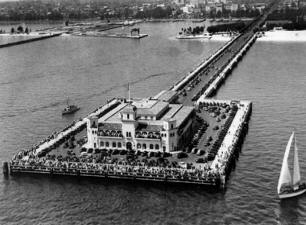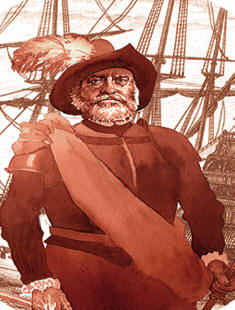|

|
|
History of St.
Petersburg
Florida
Waterside at Coguina Key St. Petersburg Florida 33705
|
 St.
Petersburg is a city in Pinellas County, Florida, United States. As of the
2013 census St.
Petersburg is a city in Pinellas County, Florida, United States. As of the
2013 census
estimate, the population was 249,688,[2] making St. Petersburg the 5th
most populous city in the
state of Florida and the largest city in Florida that is not a county
seat[3] (the city of
Clearwater is the county seat). St. Petersburg is the second largest city
in the Tampa Bay
Area, composed of roughly 2.8 million residents,[4] making it the second
largest Metropolitan
Statistical Area in the state. It is also a popular vacation destination
for both American and
foreign tourists.
The city is often referred to by locals as St. Pete. Neighboring St. Pete
Beach formally shortened
its name in 1994 after a vote by its residents. St. Petersburg is governed
by a mayor and city
council.
The city is located on a peninsula between Tampa Bay and the Gulf of
Mexico. It is connected to
mainland Florida to the north; with the city of Tampa to the east by
causeways and bridges
across Tampa Bay; and to Bradenton in the south by the Sunshine Skyway
Bridge (Interstate 275),
which traverses the mouth of the bay. It is also served by Interstates 175
and 375, which branch
off I-275 into the southern and northern areas of downtown respectively.
The Gandy Bridge,
conceived by George Gandy and opened in 1924, was the first causeway to be
built across Tampa Bay,
connecting St. Petersburg and Tampa cities without a circuitous 43-mile
(69 km) trip around the bay
through Oldsmar.
With an average of some 361 days of sunshine each year, and a Guinness
World Record for logging the
most consecutive days of sunshine (768 days),[6][7] it is nicknamed "The
Sunshine City".[8] Due to its
good weather and low cost of living, the city has long been a popular
retirement destination, although in recent years the population has moved
in a much more youthful direction.[9] American Style magazine ranked St.
Petersburg its top mid-size city in 2011, citing its "vibrant" arts
scene.[10]
The city was co-founded by John C. Williams, formerly of Detroit, who
purchased the land in 1876,
and by Peter Demens, who was instrumental in bringing the terminus of a
railroad there in 1888. St. Petersburg was incorporated on February 29,
1892, when it had a population of only some 300 people.
St. Petersburg, Florida

Downtown
Downtown St. Petersburg is the Central Business District, containing high
rises for office use,
most notably the tallest building in the city, One Progress Plaza. The
Tampa Bay Times newspaper
City hall
It was named after Saint Petersburg, Russia, where Peter Demens had spent
half of his youth. A
local legend says that
John C. Williams and Peter Demens flipped a coin to see who would have the
honor of naming the
city.[11] Peter Demens won and named the city after his home, while John
C. Williams named the
first hotel after his birthplace,
Detroit (a hotel built by Demens[12]). The Detroit Hotel still exists
downtown, but has been turned
into a condominium. The oldest running hotels are the historic Pier Hotel,
built in 1921, formally
Hotel Cordova and The Heritage Hotel, built in 1926.
Philadelphia publisher F. A. Davis turned on St. Petersburg's first
electrical service in 1897 and
its first trolley service in 1904.[13] The city's first major industry was
born in 1899 when Henry
W. Hibbs (1862–1942), a native of Newport, North Carolina, established his
wholesale fish business at the end of the railroad pier, which extended
out to the shipping channel. Within a year, Hibbs Fish Company was
shipping more than 1,000 pounds (450 kg) of fish each day.
Dredging of a deeper shipping channel from 1906 to 1908 opened St.
Petersburg to larger shipping.
Further dredging improved the port facilities through the 1910s. By then
the city's population had
quadrupled to 4,127.
In 1914, airplane service across Tampa Bay from St. Petersburg to Tampa
and back was initiated,
generally considered the first scheduled commercial airline flight. The
company name was the St.
Petersburg-Tampa Airboat Line, and the pilot was Tony Jannus, flying a
Benoist XIV flying boat. The
Tony Jannus Award is presented annually for outstanding achievement in the
airline industry. Jannus Live, a local music/entertainment venue on
Central Avenue in downtown, is als after him.
The city population continued to multiply during the 20th century, booming
in the 1940s and 1950s
and through the 1970s became a popular retirement destination for
Americans from midwestern cities,
reaching 238,647 in the 1980 census. By th however, the population had
levelled off, and has grown
by only 10,000 since then. In the decade from 2000 to 2010, the population
of the city dropped by approximately 4000 residents, while in the same
period the population of Florida increased by over two and a half million
residents.
|
|
|
|
|
|
|
 |
 |
|
|
|
|
|
|
|